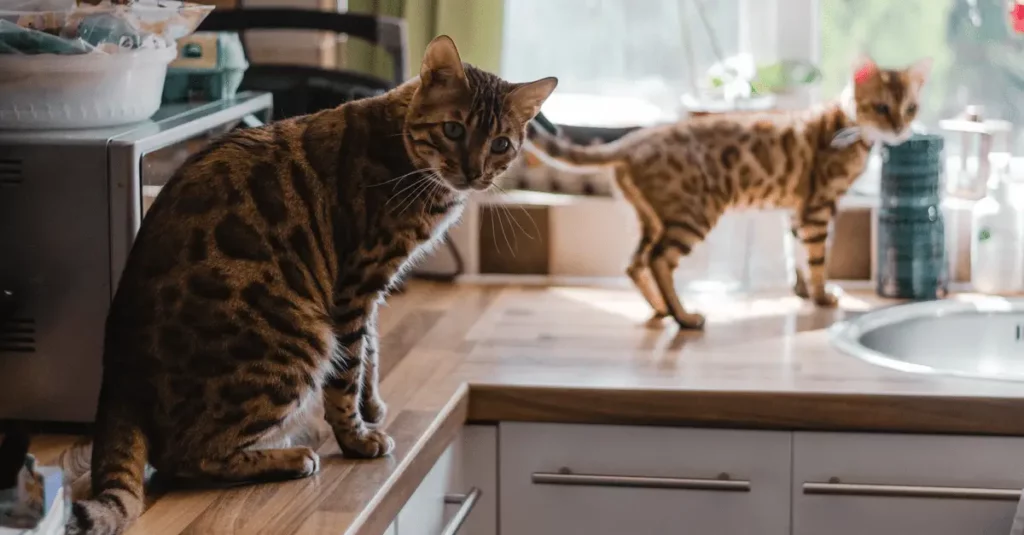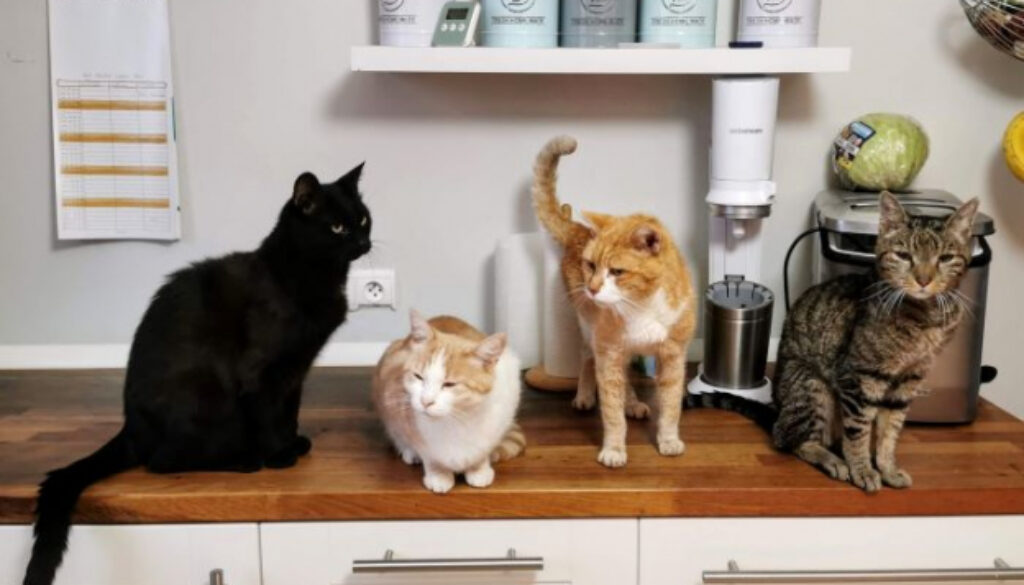Training a Cat to Stay Off Countertops
Training a cat to stay off countertops is a manageable task with the right techniques and consistent effort. By implementing effective methods and creating boundaries, you can teach your cat to respect your kitchen space and maintain a clean and safe environment. Cats are curious creatures with a natural inclination to explore their surroundings. However, the countertops in our homes are not always cat-friendly areas. Whether it’s for hygiene reasons or the safety of our furry friends, training a cat to stay off countertops is essential. In this article, we will explore effective techniques and tips to guide you through the training process and create a harmonious environment for both you and your feline companion.
Having a well-trained cat offers numerous benefits. It helps maintain cleanliness in the kitchen, prevents potential accidents, and ensures your cat’s safety. Training a cat to stay off countertops may seem like a daunting task, but with patience, consistency, and positive reinforcement, it can be achieved successfully.
Understanding a Cat’s Behavior
Before embarking on countertop training, it is crucial to understand why cats are drawn to these elevated surfaces. Cats have a natural instinct to climb, survey their territory, and seek vantage points. Countertops provide them with a sense of security and control over their environment. Additionally, cats may leave their scent and marks on the countertops as a way of marking their territory. Inadvertently, humans unknowingly reinforce this behaviour by providing unintentional rewards, such as leftover food scraps or accidental crumbs.
Creating a Safe Environment
To discourage countertop behaviour, it is essential to create an environment that meets your cat’s needs while providing alternative options. Investing in cat trees, scratching posts, or other vertical surfaces will redirect their climbing instincts. Ensuring your cat has enough mental and physical stimulation through interactive toys, playtime, and environmental enrichment can help lower their interest in countertops. Moreover, using deterrents such as double-sided tape, aluminium foil, or scented repellents on countertops can dissuade them from jumping up.

Positive Reinforcement Techniques
Positive reinforcement is a powerful tool for shaping desired behaviour in cats. Rewarding your cat with treats, praise, or affection each time they exhibit the behaviour you desire – staying off countertops – reinforces the idea that this behaviour is positive and rewarding. Consider utilising clicker training, a method that pairs a distinct sound with a reward, to mark the desired behaviour and strengthen the association.
Redirecting the Cat’s Attention
Redirecting your cat’s attention to appropriate toys and designated play areas is another effective way to discourage countertop exploration. Provide a variety of interactive toys, such as puzzle feeders or wand toys, to engage their natural hunting instincts. Engaging in regular play sessions not only keeps them mentally stimulated but also helps burn excess energy, decreasing their inclination to climb countertops.
Consistency and Persistence
Training your cat to stay off countertops requires consistency in enforcing rules and setting clear boundaries. Cats are creatures of habit, and being consistent in your approach helps them understand what is expected of them. Avoid punishment as it can damage the trust and relationship between you and your cat. Instead, focus on rewarding desired behaviour and redirecting their attention to appropriate spaces.
Using Repellents and Deterrents
Certain commercially available sprays and scents can act as deterrents by making countertops unappealing to cats. These sprays are safe for cats and typically have natural ingredients that produce odours or tastes cats dislike. Alternatively, you can try using natural deterrents like citrus peels, vinegar, or lemon-scented sprays. Additionally, noise-based deterrents, such as motion-activated alarms or devices that emit a hissing sound, can startle cats and discourage them from jumping on countertops.
Managing the Environment
Managing the environment plays a crucial role in preventing countertop access. Ensure your cat does not have an easy way to jump onto countertops by blocking off the area or using physical barriers like baby gates or cat-proof fencing. Remove temptations such as food or food scraps from the countertops, and make sure your cat has easy access to their designated food and water bowls. Keeping countertops clean and free from any potential sources of interest will make the experience less appealing for your cat.
Training Tips for Specific Situations
Addressing countertop behaviour may vary depending on your cat’s age and specific situations. If you have a curious kitten, consider baby-proofing the kitchen by limiting their access. Provide plenty of vertical spaces, such as cat trees or shelves, to meet their natural climbing instincts. For cats seeking higher ground, try installing wall-mounted shelves or cat walkways to provide alternative options. If persistent countertop behaviour continues, utilise training techniques consistently and seek assistance from a professional behaviourist if necessary.
Troubleshooting and Problem-Solving
When encountering challenges in training, it is essential to assess the underlying causes and adapt your approach accordingly. Observe your cat’s behaviour and identify any external factors that might be influencing their countertop exploration. If difficulties persist, consider consulting a veterinarian or a professional cat behaviourist who can offer personalised advice and solutions tailored to your cat’s needs.
Patience and Time: The Training Process
Training a cat to stay off countertops is not an overnight accomplishment. It requires patience, time, and perseverance. Celebrate small victories along the way, such as when your cat consistently uses their designated climbing areas or avoids the countertops during mealtimes. Remember that consistency is key, and maintaining training efforts in the long run will yield positive results.
Creating a Positive Relationship
Throughout the training process, it is crucial to build a positive relationship with your cat. Strengthen the bond by spending quality time together, engaging in interactive play, and providing your cat with love and attention. Understanding and appreciating your cat’s unique personality and needs will create a strong foundation for successful countertop training and a harmonious home environment.
FAQs: Training a Cat to Stay Off Countertops
Can I use punishment to deter my cat from the countertops?
Punishment can create a negative association and damage the bond with your cat. It is best to focus on positive reinforcement and redirection techniques.
How long does it generally take to train a cat to stay off countertops?
The training process depends on each cat’s individual personality and previous behaviour. It can take a few weeks to several months to see consistent results.
Are there any specific deterrents that should be avoided?
It is important to choose deterrents that are safe for cats and do not harm them. Avoid using any substances or methods that could potentially harm your cat’s health.
What should I do if my cat’s countertop behaviour persists despite training efforts?
If your cat’s countertop behaviour continues despite training efforts, consider seeking advice from a veterinarian or a professional cat behaviourist who can provide personalised guidance.
Can I train an older cat to stay off countertops?
Yes, older cats can still be trained using similar techniques. It might require more patience and persistence, but with consistency, most cats can learn new behaviours at any age.

Conclusion
Training a cat to stay off countertops requires understanding their behaviour, creating a safe environment, utilising positive reinforcement techniques, and managing the training process consistently. By redirecting their attention, using deterrents, and providing appropriate alternatives, you can effectively train your cat to stay off countertops. Remember to be patient, adapt to specific situations, and foster a positive relationship with your cat. By doing so, you will create a happier, healthier environment for both you and your feline companion.
Also Read:
Pet Care Tips for Cats for Beginners
Pet Care Tips for Dogs for Beginners



